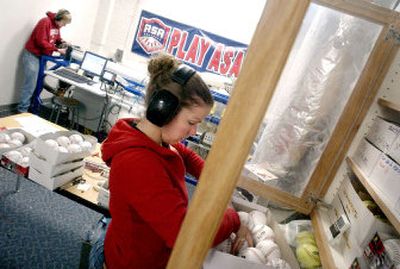Game’s a science at WSU bat lab

PULLMAN – With spring comes baseball and softball. With baseball and softball come statistics: batting averages, runs batted in, earned run averages.
But when Lloyd Smith puts bat to ball, he’s looking for different information. The coefficient of restitution. The mass motion of inertia.
In a basement lab at Washington State University, Smith and his students use an air cannon to fire softballs into bats at upward of 100 mph. It’s done mostly for manufacturers who pay the lab to make sure their bats meet the standards of the Amateur Softball Association. But the work delves into a wide range of the science of softball, from the hardness and bounce of balls to finding the “sweet spot” on a bat.
“We’re starting to do some work on cricket bats,” said Smith, an engineering professor and director of the bat lab.
If you’re one of the thousands of softball players in regional ASA leagues, you’re using a bat that had to pass muster with Smith’s cannon. His lab is one of two in the country that checks bats for the organization and was the first to develop the high-speed test.
The bat lab, in the Engineering Labs building, looks like the storage room at a softball complex. Bats hang everywhere, and softballs fill boxes. A batting cage sits against one wall, near a basketball hoop. “That’s just stress relief,” Smith said, referring to the hoop.
In the back room is the cannon, which uses pressurized air to fire softballs at stationary, pivoted bats and measures the reactions. Though the circumstances are different than regular softball – an outrageously fast pitch and no swing – the transaction translates into a measurement of how hard the bat will hit the ball when struck perfectly.
The ASA wants the ball to rebound at no more than 98 mph. It reduced the cap after working with Smith, in an attempt to keep more balls in play and prevent games from turning into home run derbies.
About six undergraduates work in Smith’s lab, and one graduate student is doing more detailed work on how bats wear out. Amanda Kramer, a sophomore studying mechanical engineering, was running the softball cannon Monday.
“I like it,” she said. “It’s something different.”
Smith began his academic career interested not in softball, but in mechanical engineering and composite materials.
But he became involved in a project to try to develop a better wooden bat and found that there weren’t solid ways of testing durability and performance.
“Bats that had the same performance in the lab had very different performances in the field,” he said.
He began working with the ASA in 2002 to develop a better test and eventually designed the cannon. He sped the ball from the old tests from about 60 mph to 110 mph – to more accurately reflect the combined speed of a softball pitch and swing.
He also found that science really can’t predict where any bat’s sweet spot will be. The spot – the place on the barrel where the bat strikes the ball the best – varies from bat to bat and must be found through experiments, he said. So in his lab, they fire lots of balls at slightly different spots on the bat to find it.
The lab also works on testing softballs. Smith said finding reliable ways of measuring the characteristics of softball is tough because there can be so much variety among them.
“Beware the ball,” he said. “The ball is the problem.”
Even trying to find accurate ways of measuring a ball’s hardness or its coefficient of restitution – its bounce, roughly – can be difficult, he said. Researchers used to squeeze them between metal plates; now they fire them at walls.
In any case, they must test the balls before they test the bats, to make sure they’re using a consistent standard.
“If it’s a good day, half the balls we try we can use to test a bat,” Smith said.